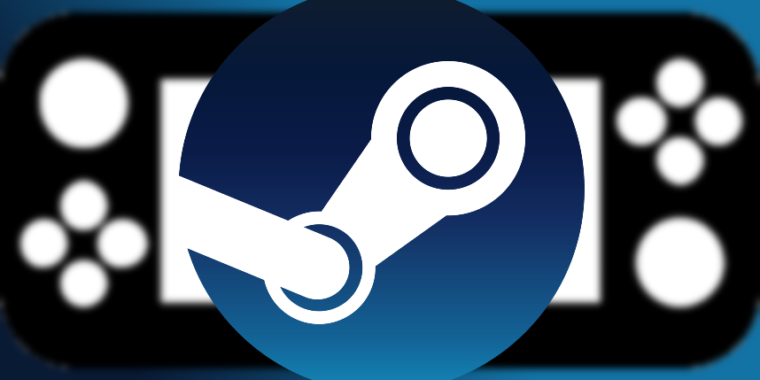We can confirm some, but not all, of what’s in store for the codenamed “SteamPal.” A combination of two corporate logos. Enlarge / Some Nintendo Switch clip art, plus a Steam logo, equals the Valve “SteamPal”? The math equation isn’t as simple as this listing image might lead you to believe. Sam Machkovech Video game and hardware studio Valve has been secretly building a Switch-like portable PC designed to run a large number of games on the Steam PC platform via Linux—and it could launch, supply chain willing, by year’s end.
Multiple sources familiar with the matter have confirmed that the hardware has been in development for some time, and this week, Valve itself pointed to the device by slipping new hardware-related code into the latest version of Steam, the company’s popular PC gaming storefront and ecosystem.
On Tuesday, SteamDB operator Pavel Djundik spotted the change in Steam’s code, which pointed to a new device named “SteamPal.” The name is a derivative of a previously discovered code term, “Neptune,” which began appearing in September of last year and came with a “Neptune Optimized Games” string. At the time, curious code crawlers thought this discovery referred to some type of controller.
Technically, that’s true. The “SteamPal,” whose name we’re putting in scare quotes because we do not have confirmation of the device’s final name, is an all-in-one PC with gamepad controls and a touchscreen. In other words, it looks and functions like a Nintendo Switch (albeit without removable “Joy-Con” controller functionality).
This device is very likely the subject of an announcement Valve co-founder Gabe Newell hinted to in a panel conversation at a New Zealand school earlier this month. There, he dodged a question about Valve’s plans for future console video games with an indirect answer: “You will get a better idea of that by the end of this year… and it won’t be the answer you expect. You’ll say, ‘Ah-ha! Now I get what he was talking about.’” Width for the sake of touch In recent years, the “Switch-like PC” category has exploded. In early 2020, Alienware revealed its first Switch-like gaming PC, but the “concept” device has not been a financial success. If you want to buy a similar device today, you’re largely looking at products from Chinese OEMs like GPD, One-Netbook, and Aya, who have slapped ultramobile PC processors and parts into a Switch-like chassis.
The SteamPal will go a similar route, with a system on a chip likely coming from either Intel or AMD, not Nvidia. (The aforementioned Switch-like PC manufacturers have leaned on both AMD and Intel for their products.) It’s unclear whether Valve will release multiple SKUs to offer customers a choice of power level, battery life, and other specs, as other Switch-like PCs have offered over the past year.
At least one SteamPal prototype version is quite wide compared to the Nintendo Switch. This extra width accommodates a slew of control options. No, Valve is likely not slapping an entire QWERTY keyboard onto its system, but the company has packed in a standard array of gamepad buttons and triggers, along with a pair of joysticks and at least one thumb-sized touchpad (in addition to the device’s touch-sensitive screen). The SteamPal’s touchpad is likely smaller than the pair of touchpads that came standard on every Steam Controller.
The SteamPal is still in the prototype stage, and its features are subject to change, as we’ve seen with prototype hardware for other Valve initiatives like SteamVR and the Steam Controller. In other words, while I’m pretty confident that the SteamPal will include a d-pad, I can’t say for sure. This also means I don’t have details on crucial hardware aspects like battery size, screen size, pixel resolution, memory, and storage capacity. The SteamPal’s Switch-like properties will include the option to “dock” to larger monitors via its USB Type-C port, but I don’t have firm details about exactly how that connection will work or whether Valve has any plans for an eventual SteamPal dock.
Lastly, the SteamPal was built with Linux as a likely target, which aligns with Valve’s continued project to make its entire catalog compatible with the open source OS, particularly through Steam Proton. That in no way means Valve’s increasingly cozy relationship with Microsoft couldn’t result in a deal to get Windows onto the SteamPal, though it would not be surprising to see Valve skip the Windows license cost per device and tell users that the SteamPal is open enough for them to customize like any other PC.
A completely different proposition than Steam Machines I have no idea how much this device will cost. Valve may very well be in a position to take a loss on every SteamPal sold in order to drive revenue through selling software on Steam, but it’s unclear whether the turbulence of chip and other supply shortages could stop Valve from getting anywhere near the Nintendo Switch’s $299 MSRP.
While Valve has had its share of rocky hardware launches (particularly with its Steam Machine partnerships with other OEMs), the Valve Index saw the company streamline its manufacturing process with something resembling significant quality control. And taking the lead on its own VR hardware meant not getting into bed with other OEMs, which is arguably one reason that Steam Machines didn’t work out as a platform. But where Steam Machines tried to sell desktop systems in a marketplace already saturated with them, Switch-like PCs are still an entirely new sector—and one where Valve might very well succeed based on getting in earlier than other major Western manufacturers.
I can confirm the device’s existence and development, and I can point to Newell’s very loud hints that something console-related will be announced later this year, but Valve is still in a position to change gears (pun intended) at a moment’s notice. The company could either delay or outright cancel this portable gaming PC project for any number of reasons. As we learned from a massive 2020 report on the development of Half-Life: Alyx, Valve loves to create, incubate, and then cancel things


